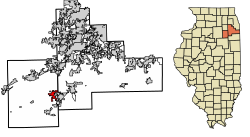History
Coal City was incorporated in 1870, named for coal mines in the vicinity [4] that were built following the 1820 discovery of large coal reserves. During the 20th century, coal mining operations in the area declined, with the local economy being driven more by growth in manufacturing and the construction of nearby power plants, [5] including Dresden Nuclear Power Plant and Braidwood Nuclear Generating Station.
2015 tornado
A confirmed EF3 tornado passed through Coal City during the outbreak of storms and tornadoes on Monday, June 22, 2015. The tornado touched down near Morris, Illinois, before entering Coal City, damaging and destroying a number of homes and businesses. According to the National Weather Service, winds reached 160 miles per hour as the tornado touched down, making it the most powerful tornado to hit the region since the Plainfield, IL tornado in August 1990. [6] [7]
Demographics
Historical population| Census | Pop. | Note | %± |
|---|
| 1890 | 1,672 | | — |
|---|
| 1900 | 2,607 | | 55.9% |
|---|
| 1910 | 2,667 | | 2.3% |
|---|
| 1920 | 1,744 | | −34.6% |
|---|
| 1930 | 1,637 | | −6.1% |
|---|
| 1940 | 1,852 | | 13.1% |
|---|
| 1950 | 2,220 | | 19.9% |
|---|
| 1960 | 2,852 | | 28.5% |
|---|
| 1970 | 3,040 | | 6.6% |
|---|
| 1980 | 3,028 | | −0.4% |
|---|
| 1990 | 3,907 | | 29.0% |
|---|
| 2000 | 4,797 | | 22.8% |
|---|
| 2010 | 5,587 | | 16.5% |
|---|
| 2020 | 5,705 | | 2.1% |
|---|
|
As of the 2020 census [3] there were 5,705 people, 1,939 households, and 1,297 families residing in the village. The population density was 970.57 inhabitants per square mile (374.74/km2). There were 2,418 housing units at an average density of 411.36 per square mile (158.83/km2). The racial makeup of the village was 91.15% White, 0.60% African American, 0.39% Native American, 0.33% Asian, 0.00% Pacific Islander, 1.31% from other races, and 6.22% from two or more races. Hispanic or Latino of any race were 7.03% of the population.
There were 1,939 households, out of which 39.1% had children under the age of 18 living with them, 50.03% were married couples living together, 9.85% had a female householder with no husband present, and 33.11% were non-families. 28.21% of all households were made up of individuals, and 12.33% had someone living alone who was 65 years of age or older. The average household size was 2.99 and the average family size was 2.55.
The village's age distribution consisted of 27.7% under the age of 18, 6.2% from 18 to 24, 30.9% from 25 to 44, 22.5% from 45 to 64, and 12.8% who were 65 years of age or older. The median age was 37.8 years. For every 100 females, there were 109.5 males. For every 100 females age 18 and over, there were 97.7 males.
The median income for a household in the village was $75,108, and the median income for a family was $97,695. Males had a median income of $66,654 versus $40,755 for females. The per capita income for the village was $36,011. About 3.9% of families and 6.1% of the population were below the poverty line, including 4.1% of those under age 18 and 4.6% of those age 65 or over.
This page is based on this
Wikipedia article Text is available under the
CC BY-SA 4.0 license; additional terms may apply.
Images, videos and audio are available under their respective licenses.





